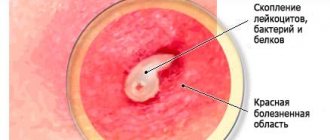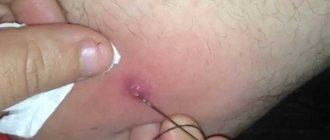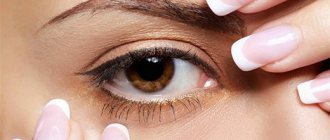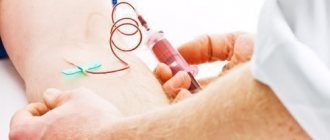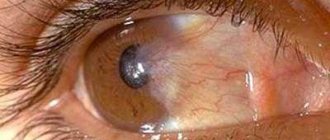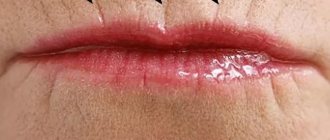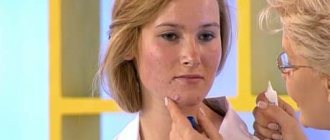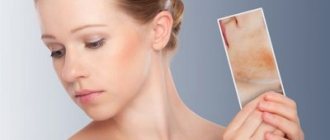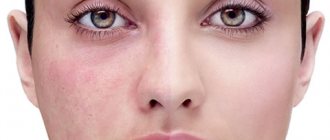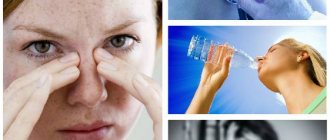Boil under the eye - what is it?
A boil is nothing more than a boil.
A boil under the eye has the form of a benign neoplasm, which is formed during inflammatory processes in the hair follicles or sebaceous glands.
The danger of this pathology lies in suppurations, the development of which is provoked by inflammation. In the absence of timely treatment or when poor-quality therapy is carried out, pathogenic microorganisms accumulate in the purulent exudate. They can cause various complications, including partial or total blindness.
A boil under the eye usually appears gradually. It has three main stages of development:
- Initially, a slight swelling appears at the site of the lesion. There may be slight redness of the skin and itching. There is a feeling of the presence of a foreign body in the eye, but upon examination of the eye nothing is revealed.
- The second stage is characterized by a twitching sensation and the appearance of severe lacrimation. Redness of the mucous membrane is also possible. Thick purulent discharge forms in the inner or outer corners of the eyes, which quickly dries out.
- At the third stage of boil development, significant visual changes can be seen. The boil takes the form of a compaction with clear boundaries; its surface may have a red or bluish tint. The head of the boil is also clearly visible. It has a yellow or white tint.
The average duration of any stage of boil development is 3 days. But depending on the etiology of the formation, the period of development of a boil under the eye may vary.
Medication methods
Traditional therapy gives results at an early stage of the disease, when the size of the swelling in the eye is small. To treat boils, ointments and drops containing antibiotics are used. They inhibit pathogenic microorganisms, as a result, suppuration goes away and the size of the barley decreases.
Select a drug for the treatment of boils in the eye area only in consultation with the ophthalmologist.
Drops
Medicines of this release form for the treatment of boils are suitable for children and adults. Bottles with medications are equipped with a pipette and dispensers, which allows you to accurately measure the required amount of medication during treatment.
Popular medications for stye on the eye:
- Albucid. Antimicrobial drug containing sulfacetamide. Belongs to the group of sulfonamides. When treating boils, it acts on streptococci, staphylococci, chlamydia. The product is used against purulent inflammation even in newborns. It has almost no contraindications and rarely causes redness and itching. For children under one year old, 1-2 drops 4-5 times a day are enough. For adults, 2-3 drops are recommended in both eyes up to 6 times a day.
- Levomycetin. Antibiotic, 1 ml contains 2.5 mg of chloramphenicol. Contraindications for use for boils include individual intolerance, skin lesions, and the first month of a child’s life. Instill 1 drop of the product three times a day in both eyes for 1-2 weeks until symptoms disappear completely.
- Phloxal. Antibacterial drops, group of fluoroquinolones. The active ingredient is ofloxacin, a broad-spectrum antibiotic with a bactericidal effect. For treatment, instill one drop three to four times a day. Allowed for use by children from one year of age.
- Tsiprolet. One of the best cures for eye boils. It contains ciprofloxacin, an antibiotic from the fluoroquinolone group. The drug is contraindicated in the treatment of eyes in children under 12 years of age and people with intolerance to the active substance.
- Tobrex. Antibacterial drug from the group of aminoglycosides. The active ingredient is tobramycin. It eliminates staphylococcus, streptococcus, enterococcus. For boils, Tobrex is instilled 1-2 drops every 3-4 hours.
READ ALSO: How to remove acne on a teenager’s face: do’s and don’ts
Choosing the wrong drops for treatment can worsen the condition. Use eye medications as prescribed by your doctor.
One of the best ways to eliminate stye on the eye is with ophthalmic ointments for treatment. They have a thicker consistency than drops and their effect is longer. Boil remedies contain antibiotics, antiviral substances that inhibit pathogenic microorganisms. As a result of using ointments for a week, the abscess bursts. The medication prevents the spread of infection and protects against re-infection.
Popular drugs for boils:
- Tetracycline ointment. Contains the same antibiotic. It penetrates bacterial cells and blocks protein synthesis in them. Apply the ointment to the eyelids in a thick layer up to 5 times a day until the stye disappears.
- Erythromycin. A drug from the macrolide group. The eye treatment is used only for 3-4 days, otherwise it becomes addictive and stops working. The ointment relieves swelling well and heals damaged tissue after an abscess ruptures. Use up to 5 times a day.
- Tobrex. Bacteriostatic and bactericidal medicine. Gets rid of boils on eyelids and eyebrows. To enhance the effect of treatment, it is recommended to use drops of the same name. Apply Tobrex to your eyelids three times a day for a week. For the first 2 days, doctors advise using it every 4 hours.
- Colbiocin. A product containing three antibiotics. They are maximally active against different types of bacteria. If an abscess swells on the eyelid, apply ointment 3-6 times a day for treatment until recovery.
- Eubital. The drug contains several antibiotics. They fight infection, eliminate the feeling of eye puffiness and inflammation. To enhance the effect, combine with other means - over time, addiction occurs. Apply the ointment up to 4 times a day. If you are using drops to treat a boil, use Eubital only at night.
- Phloxal. Antibacterial ointment based on ofloxacin. Copes with different types of bacteria, including chlamydia. The drug is administered three times a day.
READ ALSO: Typhus - Medical Encyclopedia
The choice of ointment depends on the severity of the eye disease and should be agreed with the doctor.
Other
In addition to ointments and drops, you can use other antiseptic agents for treatment that are available at the pharmacy:
- alcohol. Use to wipe the boil 2 to 4 times a day. Alcohol infusions relieve inflammation and disinfect;
- brilliant green An antiseptic that is recommended to lubricate boils on the eye. The solution does not cause pain and helps to quickly cope with the disease.
- iodine. The abscess must be lubricated carefully. Take a match, wrap it in cotton wool and dip it in the iodine solution. Gently apply the medication to the boil. Repeat treatment 2-3 times a day.
Simple antiseptics cope with boils at an early stage no less effectively than antibacterial medications.
Do not allow antiseptics to come into contact with the mucous membrane of the eye. This can cause a chemical burn to the conjunctiva.
What could be the reasons?
You should not try to squeeze out a boil yourself, it can be dangerous.
The appearance of a boil under the eye occurs with the development of pathological processes in the hair follicles. This area is located in the lash line. Inflammation begins when white or aureus staphylococcus enters the follicle. It begins to multiply rapidly and causes a response from the body, manifested in an increase in size, color and swelling of the affected area.
In medical practice, the main causes of boils under the eye are identified. These include:
- Poor personal hygiene.
- Using unsuitable cleaning agents.
- Applying low-quality cosmetics to the skin.
- Presence of chronic dermatological diseases.
- Avitaminosis.
- Mechanical damage to the skin in the eye area in the form of abrasions and scratches.
- Increased oiliness of facial skin.
- Tendency to acne.
- Parasitism of the Demodex mite on the skin of the face.
Also, the risk of a boil under the eye increases significantly with prolonged stay in environmentally polluted areas and with constant contact with dust.
Reasons for the formation of a boil on the eye
The most common cause of a boil on the eye is a bacterial infection, which in 95% of cases is caused by Staphylococcus aureus.
Many factors can provoke the development of infection, among which the most common are:
- lack of vitamins and minerals, and as a result, a decrease in the body’s defenses;
- the presence of minor damage to the skin through which microorganisms penetrate;
- frequent hypothermia;
- failure to comply with personal hygiene rules (eye contact with dirty hands or a towel);
- use of low-quality or foreign cosmetics;
- infection with demodex mites.
In addition, the reasons may be hidden in concomitant pathologies, namely:
- chronic diseases of the digestive system;
- metabolic disease;
- diabetes;
- the presence of viral infections of a chronic nature;
- blepharitis (inflammation of the eyelid);
- furunculosis.
Heredity plays a major role in the formation of the follicle. If one of the parents often exhibits this pathology, then in 50% of cases, a boil will appear on the child’s eye.
Symptoms of a boil under the eye
The inflammatory process with the formation of pus, provoked by staphylococcus, has characteristic signs. Symptoms of a boil under the eye appear as:
- The appearance of pain when palpating the affected area.
- Redness of the skin under the eye.
- Slight decrease in vision.
- The presence of swelling of the skin.
- Pain when moving the eyeball and eyelid.
- Constant compaction of the structure of the boil.
- Rapid growth and lack of clear boundaries of the boil.
- Increased body temperature that does not decrease for several days.
- The presence of general weakness.
- Enlarged regional lymph nodes.
With the development of a boil under the eye, the general condition worsens significantly and the ability to work decreases. Therefore, at the first signs you should contact an ophthalmologist.
Treatment of chiria on the eye
Treatment for a boil should begin with a visit to a doctor, who will select an effective treatment plan aimed, first of all, at eliminating the cause that influenced the formation of the boil. Treatment can be either conservative or requiring surgical intervention.
Drug treatment
The most widely used drug therapy for boils. The specialist, first of all, prescribes antiseptic and antibacterial agents in drops and ointments.
Effective antibacterial ointments contain substances that can fight staphylococcal infections - these are Tetracycline, Levomycetin or Erythromycin.
In treatment, drops and ointments with different active ingredients are usually used simultaneously. In the first days, treatment of the inflamed eyelid with drugs is carried out every 2-4 hours. Afterwards, a sterile bandage is applied to the eyelid for 30 minutes.
After opening the abscess, it is treated with antiseptic agents.
Surgical intervention
Surgical intervention in the treatment of boils becomes necessary in the following cases:
- the boil does not open for more than 5 days;
- many purulent foci of inflammation;
- ineffectiveness of prescribed drug therapy;
- a sharp decrease in vision in the affected eye;
- formation of deep purulent infiltrate;
- persistence of inflammation, pain and increased body temperature after self-opening of the abscess.
If the boil itself cannot open, the doctor disinfects the affected area. Next, under local anesthesia, make a puncture or incision with a sterile instrument, after which the pus is removed and the wound is treated with an antiseptic. The rehabilitation period after such an intervention lasts about a week.
Modern ophthalmology also offers the use of laser therapy.
Traditional methods
Despite the wide range of medications, many people treat stye using folk remedies. However, these methods must be used carefully to avoid infection and only after consultation with a specialist.
The most common recipes for lotions, tinctures and dry compresses:
- Tomatoes. Placing a small part of a tomato on your eyelid can reduce pain and irritation. This compress is done for 5 minutes 3 times a day.
- Turmeric. Add 1 tablespoon of turmeric to 0.5 liter of water and boil until the water boils by half. The resulting medicine is filtered and used as drops 3-4 times a day.
- Tea brewing. Apply a cooled bag of green tea soaked in boiling water to the affected eye 3 times a day.
- Honey cake. To make the abscess open faster, mix 1 tablespoon of honey with flour and make a cake. Next, attach it to the boil with a bandage and hold it until the abscess is opened.
- Aloe. The aloe leaf is softened and poured with a glass of warm water. After cooling, use it as a compress.
Traditional medicine methods are best used in combination with drug treatment and in the absence of complications.
Differential diagnosis
A boil must be differentiated from a stye, but this will not cause any difficulties for an experienced ophthalmologist.
A quick correct diagnosis affects the success of treatment of a boil under the eye. This pathology has similar symptoms to other diseases, so differential diagnosis is used in diagnosis. It allows you to distinguish furunculosis from abscess, barley, dacryocystitis and dacryoadenitis.
Diagnosis of a boil under the eye is usually carried out using a comprehensive examination. It includes:
- Physical examination.
- Dermatoscopy.
- Bacteriological culture of exudate.
- Clinical and biochemical blood test.
- Ultrasound examination of the affected area.
Based on the test results, the type of pathogen and the degree of development of furunculosis are determined. Such an examination is sufficient for a single boil.
If the disease constantly recurs, additional examination is prescribed. Typically it consists of:
- Blood test for glucose levels.
- Bacteriological culture of urine.
- Rhinoscopy.
- Fluorography.
- Ultrasound of internal organs.
- Examination by narrow specialists.
When undergoing the diagnostic complex, it is important to follow all the rules for taking tests. This reduces the error of the results and allows you to quickly make an accurate diagnosis.
Symptoms
Styes appear with equal frequency in both the left and right eyes. Hordeolum can pop out on the upper and lower eyelids, as well as in the corner of the eye (usually in the inner one).
The symptoms of this disease are as follows:
- redness of the eyelid;
- swelling of the eyelid - the eye swells and is difficult to open (this is especially pronounced if the abscess is located above the eye);
- pain in the area of the affected eyelid, intensifying when palpated;
- the eyelid itches and itches;
- Sometimes symptoms of intoxication appear - headache, fever, general weakness.
Methods for treating a boil under the eye
In some cases, medications will help eliminate a boil under the eye.
A boil under the eye is a dangerous disease, so self-medication in this case is unacceptable. It is also strictly forbidden to use traditional methods and especially heating. This can contribute to the spread of infection throughout the body and trigger the development of sepsis.
In medical practice, several therapeutic methods are used to treat boils under the eye. The main ones are:
- Medication.
- Surgical.
As additional methods, the use of traditional medicine is allowed. Herbal decoctions for oral use are usually prescribed to strengthen the immune system.
Drug treatment
When treating a boil under the eye, medications are intended for symptomatic and local treatment.
Most often, ophthalmologists prescribe:
- An ointment that contains antibiotics of different groups: Erythromycin, Tetracycline, Levomecithin.
- Antiseptic and antibacterial drops: Ciprofloxacin, Albucid, Tobramycin.
- Applications with antiseptic and anti-inflammatory drugs.
- Antibiotics for oral use: Ampiox, Cefipime, Sumamed.
When treating a boil under the eye, potent drugs are used. Therefore, they should only be prescribed by an ophthalmologist or ophthalmologist.
High therapeutic effectiveness is observed with complex treatment. The simultaneous use of oral medications and ointments can eliminate swelling, inflammation and speed up the process of boil maturation.
Also, with this treatment, rapid healing of the wound occurs after the boil breaks through, which prevents the formation of scars and tissue on the skin.
Surgery
There is a rule in surgery: “Where there is pus, there is an incision.”
Therefore, the main method of treating a boil is opening the lesion and sanitation. This technique is used when conservative therapy is ineffective. The operation is performed in a hospital by a doctor under local anesthesia. To do this, the boil is injected with anesthetics. Then the boil is opened, the pus is removed from it, and the cavity is washed with an antiseptic solution. For quick healing, a special medicine is infused into the wound.
When treating a boil under the eye with medications prescribed by a doctor, the prognosis for recovery is always positive. Qualified medical care for this pathology helps to quickly stop inflammatory processes, clean the boil cavity from pus and remove the necrotic core. This prevents the infection from spreading throughout the body and eliminates relapse.
Treatment for a boil under the eye is usually carried out on an outpatient basis or at home. Only in an advanced state does treatment of a boil require inpatient conditions.
When is surgery necessary?
In the early stages, treatment of a boil on the eyelid is carried out using traditional methods. If the boil does not decrease or recurs, the general condition worsens, surgery is prescribed to quickly rid the patient of the abscess without serious consequences.
Surgical intervention on a boil takes place according to the following treatment plan:
- The patient is positioned and taken to the operating room.
- The head is covered with a cloth, leaving only the working surface where the boil is located free.
- The surgical site around the eye is treated with antiseptics.
- Anesthesia is injected into the treatment area.
- The surgeon puts a special clamp on the eyelid with a boil to prevent it from moving. If surgery is planned on the inner eyelid, it is turned outward. The clamp helps prevent bleeding.
- The formation on the eye is opened with a scalpel or laser, the purulent-necrotic rod is removed, and washed.
- The wound is sutured and stitched.
- Treat with an antiseptic, apply a compress with antibacterial ointment and cover with an aseptic bandage.
READ ALSO: Nise Gel: instructions for use, active ingredient
The rehabilitation period after treatment of a boil lasts no more than a week and usually does not cause complications.
Possible complications
A boil under the eye responds well to treatment in the initial stage. If it is not carried out, the disease takes a severe form. In this form, the pathology is often accompanied by the development of serious complications.
Most often, the negative consequences of a boil under the eye are manifested by the development of:
- Inflammation of the cornea.
- Phlegmon.
- Sepsis.
- Meningitis.
These pathologies not only significantly reduce the level of general health, but can also lead to irreversible loss of vision and even death.
Also, when treating an advanced boil, the likelihood of unethical scars on the face increases, which can greatly distort external attractiveness.
The main method of treating boils
Only the attending physician can make a correct diagnosis. When a chiryak first appears before your eyes, you should go for an examination. Depending on the individual characteristics of the patient’s body, the doctor will select the best treatment method for him. Your doctor will probably suggest one of these methods:
- Medication. The medical method involves the use of antibiotics. Antibiotics are serious medications that should not be used without a doctor's prescription. Drug treatment is gentle. The patient does not experience pain, and the disease goes away after 3 or 4 days. Medicines are usually available in the form of ointments or eye drops. Known drugs: erythromycin, tetracycline, albucid. Another option is sterile bandages impregnated with medications - they quickly remove the boil of the eyelid. If necessary, the doctor can perform injections. Medicines will help the boil ripen faster.
- Surgical. When medications do not give the desired effect or the boil is too large, it is removed surgically. The patient does not feel pain during the operation due to anesthesia. The surgeon makes a careful incision so that the pus comes out of the boil. Medicine is injected into the cavity. The eye is a vulnerable organ; attempting to remove a boil from it yourself can lead to injury. Even if the boil is not on the eyelid, but on another part of the face, say, on the bridge of the nose, it is better to have it removed by a doctor.
You can’t just remove a chiryak that has grown on the eye. Doctors prescribe remedies and therapy to restore immunity: “The first step to healing is to understand the cause of the problem.”
Albucid, a popular eye drop
Prevention methods
By following simple rules of prevention, you can minimize the chance of a boil appearing under the eye.
Prevention allows you to prevent the appearance of a boil under the eye. Doctors recommend the following as such measures:
- Wash your hands thoroughly with soap after visiting public places and walking outside.
- Strengthen the immune system with herbal and medicinal preparations.
- Use only high-quality hygiene products and detergents for facial skin care.
- Use high-quality decorative cosmetics.
- Take frequent walks in the fresh air.
- Avoid getting debris and other foreign bodies into your eyes.
- Follow a proper nutrition system.
- Minimize your stay in dusty rooms.
- Do not touch your face with dirty hands.
- Do not use someone else’s decorative and hygienic cosmetics.
The effectiveness of prevention depends on the frequency of its observance. By constantly adhering to these recommendations, you can not only prevent the development of a boil under the eye, but also eliminate the recurrence of the disease.
Regardless of the cause of its appearance, a boil under the eye has clear symptoms. Therefore, this disease can be identified at an early stage and receive adequate treatment in a timely manner.
In the video below, ophthalmologists talk about a disease similar to boils - barley:
Features of treating a boil on a child’s eye
The treatment of boils in children must be approached more seriously, since boils can cause headaches and fever. Infants are treated in a hospital setting.
The prescription of medications takes into account the age of the child and the characteristics of the disease.
The most effective drops are:
- Ofloxacin;
- Levomycetin;
- Tobramycin;
- Albucid;
- Maxitrol.
Recommendations for using drops in a child:
- If the drops are cold, in order not to chill your eyes, you need to warm them by holding them in your palms for several minutes.
- Before carrying out the procedure, wash your hands with soap, but under no circumstances wipe them with alcohol.
- The child's head should be thrown back, his gaze directed upward;
- Before instilling the next drug, at least 30 minutes must pass.
- No more than two drops are instilled into one eye.
When treating boils in children, it is important that the child is always under the supervision of adults, since he can rub his eyes with his hands, which can aggravate the situation.
Preventive methods
To prevent boils on the eye from bothering you and becoming chronic, you need to adhere to preventive measures:
- wash your hands more often;
- do not touch your eyes with dirty hands;
- cosmetics must be hypoallergenic;
- buy eye cosmetics of proven quality;
- lead an active lifestyle aimed at increasing immunity;
- correctly remove a foreign body from the eyes.
If you notice the first symptoms of a boil, you should immediately consult a doctor. Timely treatment eliminates the development of complications and negative consequences.
How it manifests itself
The symptoms of a boil appear in stages. Initially, an itching sensation occurs at the site of its formation.
Then redness, swelling, and soreness appear on the upper or lower eyelid. Often a person feels as if there is a foreign body in the eye.
The boil ripening process lasts several days (from 2 or longer). The transition of inflammation to a purulent form is accompanied by accompanying symptoms:
- weakness and malaise as a result of intoxication of the body;
- increased body temperature;
- feeling of nausea;
- headaches.
A boil on the inside of the eyelid manifests itself as more noticeable pain. At the initial stage, it can be visually detected by slightly turning the eyelid.
After the boil matures, it opens, the pus comes out, the swelling subsides, and the redness gradually disappears.
As soon as the first symptoms of a boil appear and swelling under the eye begins to form, treatment should begin. It is possible that the resulting infiltrate will resolve and the purulent stage of the disease can be avoided.
How to treat boils on the eyelid and eyebrows
The most reasonable decision in a situation when the first signs of a boil on the eye appear is to seek medical help.
Correct diagnosis of the disease is very important - a boil should be distinguished from other pathologies, for example, an abscess.
The doctor will select an individual treatment regimen that will ease the course of the disease and help avoid complications.
A boil is treated with:
- Conservative therapy (using medications).
- Folk remedies.
- Surgical intervention.
Drug therapy
An abscess on the eye is treated with drops, ointments, and in severe cases, antibiotics taken orally.
For the treatment of boils, the use of eye drops with a pronounced antiseptic and antibacterial effect is effective:
- Albucida;
- Tsiproleta;
- Tobramycin;
- Tobradex;
- Levomycetin;
- Ciprofloxacin.
These drugs actively fight staphylococci and block the inflammatory process.
In the treatment of boils on the eye and eyebrows, the use of ointments with an antibacterial effect is effective:
- Tetracycline;
- Levomycetinova;
- Erythromycin;
- Hydrocortisone.
Ointments successfully suppress the action of pathogenic microflora, relieve inflammation, and accelerate healing.
The drug is either simply applied to the affected area or a gauze bandage is soaked in it, which is fixed at the location of the boil.
The ointment, unlike drops, acts locally - directly on the boil, as it is applied only to the problem area.
Also, to treat boils on the eye, compresses with medications that have anti-inflammatory and antiseptic effects and physiotherapy are used.
Antibiotics in tablet form are rarely used when a boil appears on the eye, unless the disease is severe.
Broad-spectrum drugs can be prescribed:
- Flemoclava;
- Amoxicillin;
- Flemoxin Solutaba;
- Cephalexin;
- Tseporina.
If a boil appears on the eye, you should temporarily stop wearing contact lenses and using decorative cosmetics. This will prevent the further spread of staph infection.
Particular care should be taken when treating boils on the eyebrows above the eye to avoid possible complications such as blurred vision, inflammation of the facial nerve, and meningitis.
At home, boils are treated with gauze swabs with Levomekol or Vishnevsky ointment. The skin around the boil is treated with hydrogen peroxide, furatsilin solution, and salicylic alcohol.
Therapy should be carried out strictly on the recommendation of a doctor, who will prescribe compresses, physiotherapeutic procedures, and antibiotics - depending on the severity of the disease. It may be necessary to open the abscess by a surgeon.
In what cases and to whom are antibiotics prescribed for furunculosis, we wrote here.
Surgery
Surgical intervention is used to treat a boil on the eye if it is not possible to cure the abscess using conservative methods.
